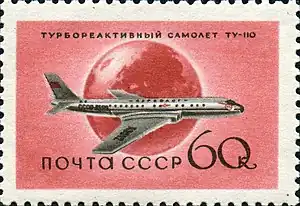| Tu-110 | |
|---|---|
 | |
| Tu-110 on a 1958 Soviet postage stamp | |
| Role | Jet airliner |
| National origin | USSR |
| Manufacturer | Tupolev |
| Designer | Dmitriy S. Markov |
| First flight | 11 March 1957 |
| Status | Never entered service |
| Number built | 4 |
| Developed from | Tupolev Tu-104 |
The Tupolev Tu-110 (NATO reporting name: Cooker) was a jet airliner designed and built in the USSR, which saw its maiden flight in 1957.
Design and development
Realising that the export potential for the Tupolev Tu-104 was limited, the Council of Ministers issued directive No. 1511–846 on 12 August 1956, requiring the Tupolev Design Bureau to develop a four-engined version of the Tu-104, to enable the aircraft to safely cross large expanses of ocean, and improve safety on takeoff in case of engine failure.
The Tu-110 was a major redesign of the Tu-104, powered by four Lyulka AL-7 turbojets rated at 5,500 kgf (53.9 kN; 12,100 lbf) thrust each, with two staggered engines in the root of each extended centre-section. The first prototype was flown on 11 March 1957.
Production of the Tu-110 was authorised at the Kazan Aircraft Factory, with an initial order for ten aircraft, but only three aircraft were completed before the programme was terminated. The production aircraft featured extended-chord wings and enlarged baggage holds, as well as seating for up to 100 passengers in an all-tourist class seating arrangement.
All four aircraft were converted to Tu-110Bs with Soloviev D-20 turbofan engines, in an attempt to improve the performance of the aircraft, but to no avail. No further orders were forthcoming and the four Tu-110Bs were used for experimental work on avionics, missile systems and boundary layer control systems, remaining active into the 1970s.
Variants
Data from Tupolev Tu-104[1]
- Tu-110 – The sole prototype of the Tu-110 (CCCP-L5600).
- Tu-110A – Production aircraft with doubled seating capacity (all economy class), increased capacity baggage holds, increased area flaps and increased MTOW of 87,200 kg (182,320 lb). Three aircraft were built (CCCP-L5511 – L5513)
- Tu-110B – Experimental medium-haul versions converted from the prototype and three production aircraft, fitted with four Soloviev D-20 turbofan engines.
- Tu-110L – The prototype aircraft modified with boundary layer control supplied with bleed air from the D-20 turbofan engines.
- Tu-110D – A projected medium-haul airliner with four D-20 engines in paired nacelles on either side of the rear fuselage,
- Tu-117 – A projected military transport version with a rear fuselage loading ramp and defensive tail turret.
Specifications (Tu-110 1st prototype)
Data from The Osprey Encyclopaedia of Russian Aircraft 1875– 1995[2]
General characteristics
- Crew: five (flight crew)[3]
- Capacity: 100 passengers[4]
- Length: 38.30 m (125 ft 8 in)
- Wingspan: 37.50 m (123 ft 0 in)
- Wing area: 182 m2 (1,960 sq ft)
- Empty weight: 44,250 kg (97,555 lb)
- Max takeoff weight: 79,300 kg (174,827 lb)
- Powerplant: 4 × Lyulka AL-7 turbojet, 64 kN (14,300 lbf) thrust each
Performance
- Maximum speed: 1,000 km/h (620 mph, 540 kn)
- Cruise speed: 890 km/h (550 mph, 480 kn)
- Range: 3,450 km (2,140 mi, 1,860 nmi)
- Service ceiling: 12,000 m (39,000 ft)
See also
Related development
Related lists
References
Notes
Bibliography
- Gordon, Yefim and Vladimir Rigmant. Tupolev Tu-104. Hinkley, UK: Midland, 2007. ISBN 978-1-85780-265-8.
- Gunston, Bill. The Osprey Encyclopaedia of Russian Aircraft 1875– 1995. London: Osprey, 1995. ISBN 1-85532-405-9.
- Stroud, John. Soviet Transport Aircraft since 1945. London: Putnam, 1968. ISBN 0-370-00126-5.